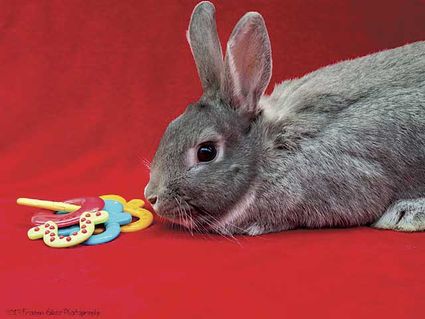How about a long-eared companion?
A bunny may be the pet for you
June 1, 2017

Photo courtesy Anchorage Animal Care and Control
Rabbits as pets don't come close to dogs or cats in popularity, but they offer their own charms.
Typically, when people think of animal companions they think of dogs and cats. But not everyone wants to, or can, walk a dog or has a secure enclosure for a dog to spend time outside. And some folks are allergic to cats. So we have another suggestion for you: rabbits. Yes, rabbits.
Rabbits don't enjoy the popularity of dogs and cats. In fact, according to the House Rabbit Society there are only an estimated 3 to 7 million pet rabbits. That's a small number compared to the estimated 78 million dogs and 85 million cats (estimate from the American Pet Products Association). So we're here to give a shout-out to rabbits!
Before hopping in
Let's start with a few things to take into consideration before adopting a rabbit.
• Not sure if you'll enjoy a rabbit as a pet? If you prefer pets who are always ready to interact with you and want to please you (think: dog) or who want to sleep in your lap for hours (think: cat) then a rabbit may not be right for you. But if you enjoy observing animals and slowly winning an animal's trust and affection then you may love living with a rabbit.
• Do you have the space for a cage (a rabbit's cage should be 4x its body length when laying down) and an area of the home you can rabbit-proof so your rabbit can get out for exercise?
• Is your home generally calm and quiet? That's good because prey animals, like rabbits, don't like fast movements and loud noises.
• Does the potential for nibbling on your books or clothing sound maddening or endearing? Rabbits will nibble these things, so be prepared.!
Building the relationship
Once you've decided to bring a rabbit home you'll need to gain their trust. As you're working on building a bond with your rabbit, keep in mind they are prey animals so they're naturally wary. But they're also curious and will eventually check you out.
• Start by getting down on their level where they feel safe and can see more than just your feet and legs. Take a seat on the floor and be patient.
• Talk softly. Rabbits like listening to calm and quiet voices.
• Once your rabbit approaches you, offer him or her a few treats, such as small bits of carrots or apples.
• When your rabbit is next to you gently stroke them him/her and let them scamper off when they are done.

Photo courtesy Anchorage Animal Care and Control
Rabbits have a sense of curiosity and will interact with toys.
• Play with your rabbit. Toss plastic cups, plastic baby keys and wooden blocks so your rabbit can investigate them.
• Eventually, your rabbit will begin giving you gentle nudges to ask for your attention, as she or he would to another rabbit, and now you know you are trusted.
• Learn the proper way to support your rabbit when you hold her/him. Only pick up and hold your rabbit when necessary, as being lifted above the ground is scary.
Once you've established this bond you and your rabbit can enjoy sitting next to each other, playing together, and maybe even go out on walks with your rabbit on a harness and leash.
To learn more about rabbits, visit the House Rabbit Society website at http://www.rabbit.org.
Laura Atwood is the Anchorage Animal Care and Control public relations coordinator.








